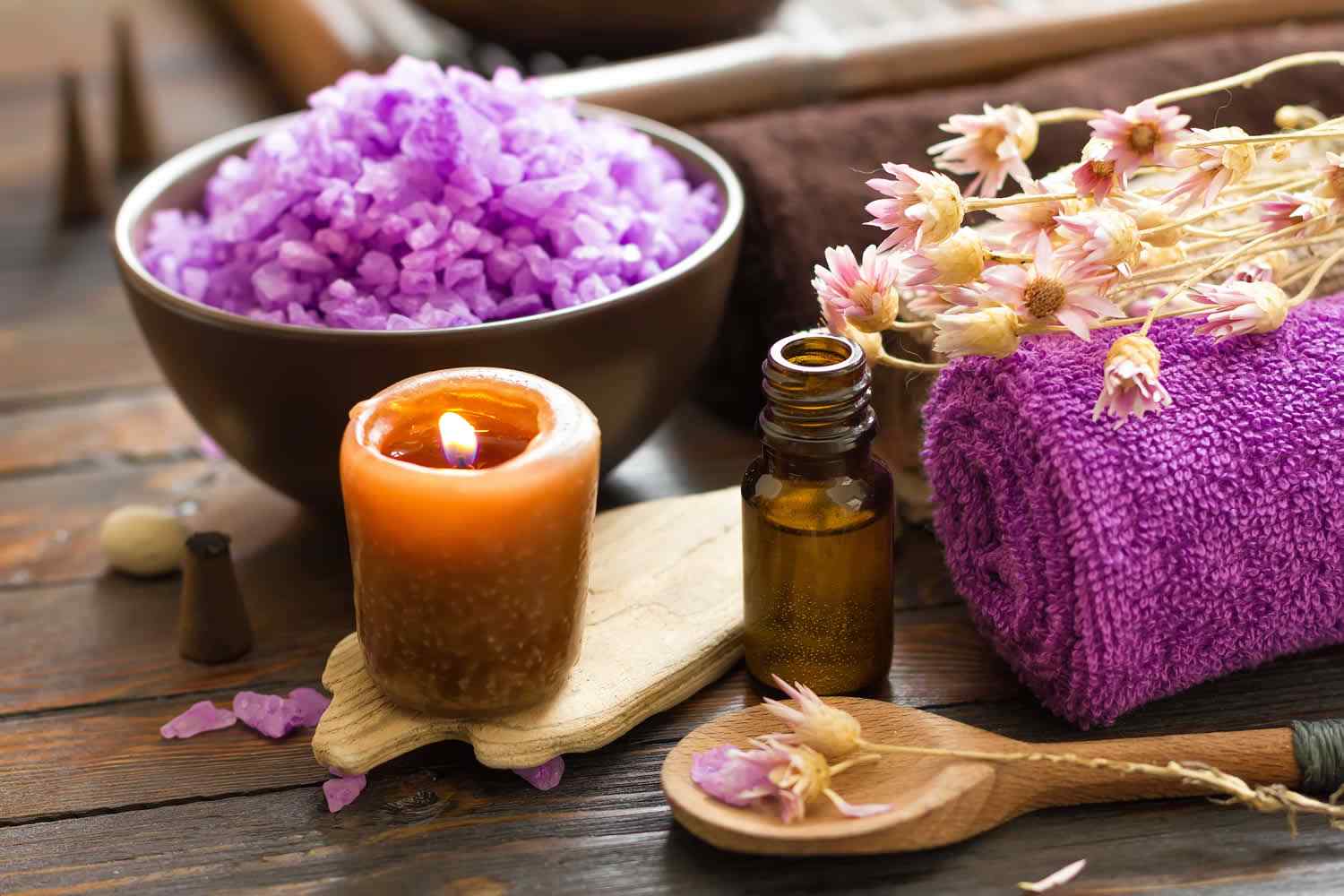A biennial plant commonly known as Garden Angelica or Angelica archangelica has a diverse use in food, beverage, herbal medicine, and as a source of valuable essential oil. In the first year, the angelica plant only grows leaves; later, its fluted stem can grow as tall as 2.5 meters. Its leaves contain numerous leaflets divided into three main groups with a serrated end in every leaf. This article will discuss the best 11 Angelica Root Essential Oil Benefits and Uses.
The yellowish-green flowers of angelica bloom in July are a cluster of myriad small flowers. The most valuable part of the plan is the mature roots from the two-year oil plants. After complex distillation, the root contains the most potent chemicals in the essential oil.
Page Contents
What Is Angelica Root?
Despite numerous use of different plant parts, the root from the plant is the most valued chemical and is used as the primary source of essential oil. After the supercritical fluid extraction method, the plant provides pale yellow or orangeish brown oil with a powerful woody aroma that resembles pepper.
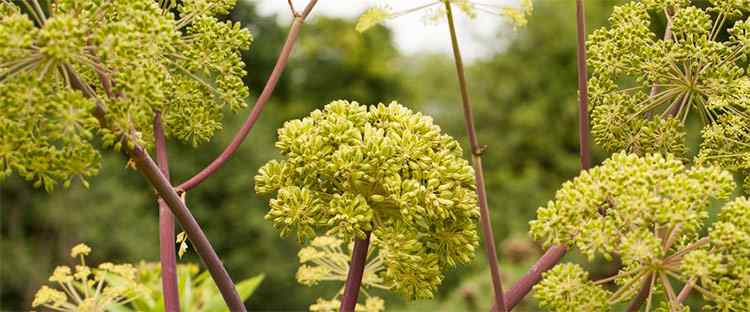
The essential oil has a robust soothing property that helps with respiratory issues. Moreover, it has antibacterial, antifungal, and anti-inflammatory properties, making it one of the most sought-after components for skin and hair products. Besides dermatological uses, it has a long history of use for medicinal purposes. It can ease some medical problems without many side effects.
Origin And Cultivation of Angelica Root
Angelica root, known as wild celery or Norwegian Angelica, is native to Eurasia. Some species are also found in North America. According to some legends, once an angel revealed the secret to a monk in his dream, that angelica plant can cure the plague and give protection against evil spirits. Since then, the plant got its name angelica and is called “The Root of the Holy Ghost,” In ancient times, it was considered one of the most potent herbs on earth.
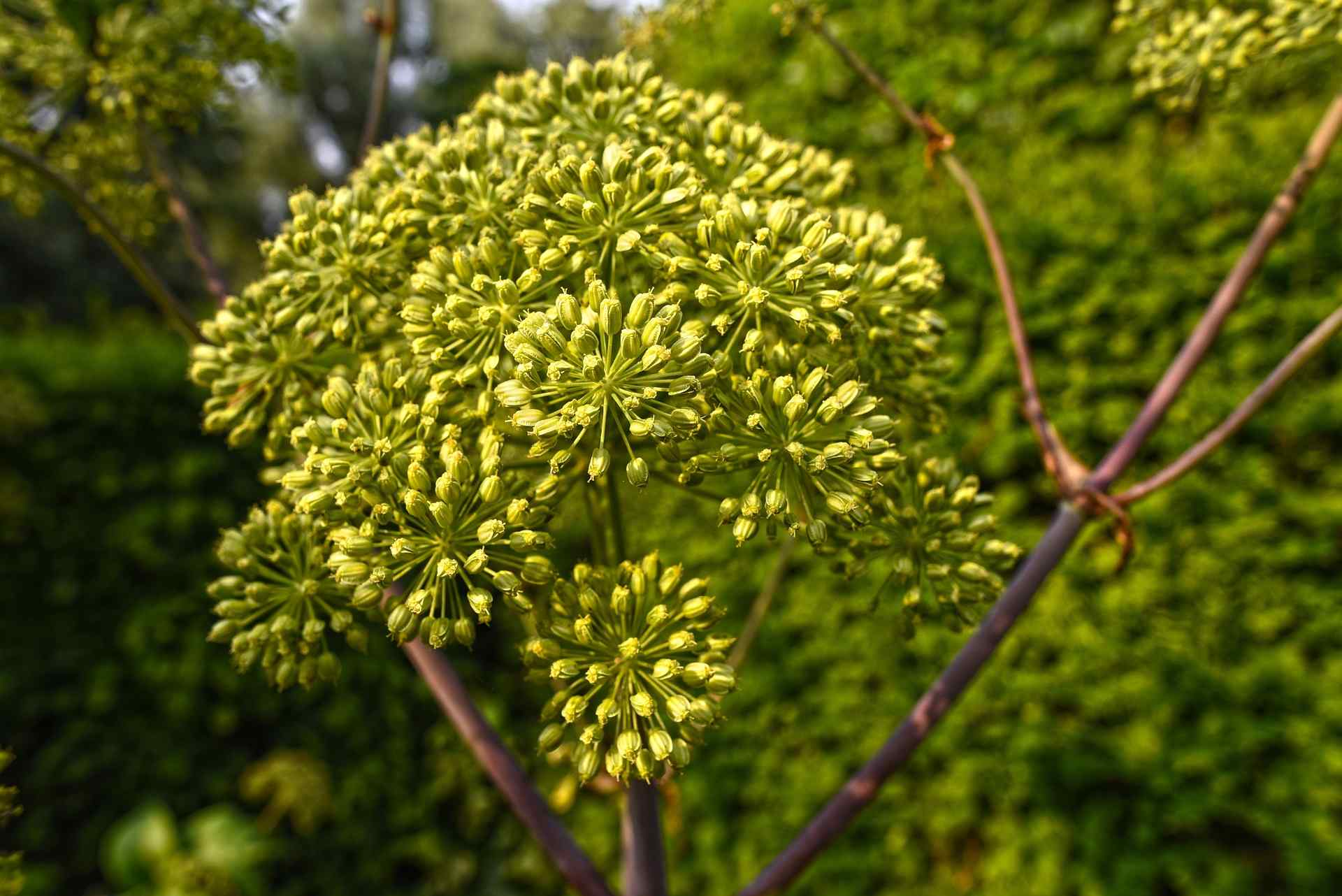
The advent of the angelica plant may be older than you thought. A well-documented use of it was found in Europe during the plague epidemic of the early 16th century. Another variant of Angelica has been used in China for over 400o years.
Wild Angelica grows in Finland, Sweden, Norway, Denmark, the Faroe Islands, and Iceland. However, the high demand for this essential oil has driven a rapid move to commercial cultivation. Most of the cultivation occurs in India and China, and the rest of the world mainly depends on importation. The USA and Germany are the top importers of this oil.
Like the commercial producers, you can cultivate your angelica root in your backyard. Angelica cultivation requires humus-rich and moist soil with low to moderate sunlight. You can cultivate it in partial shade. The best time to plant the seed is in spring. Angelica is a biennial plant, meaning you can only grow the leaves in the first year. In the second year, you may witness the growth of stems, flowers, and mature roots for oil extraction. Cultivating in a colder environment may take 3-4 years instead of two.
Nutritional Value
Angelica is well regarded due to its versatile chemical composition, which is the core of its diverse use. The following part will discuss this oil’s prominent chemical presence and benefits.
Angelica oil is rich in α-pinene (29.7%), which is well known for its antibiotic resistance modulation. Moreover, it has antimicrobial, anti-inflammatory, anticoagulant, antimalarial, and antioxidant properties.
This oil contains a fair amount of Myrcene (4.1%) which functions excellently as a sedative in bodily pain. Besides, it can provide you with antidiabetic and anticancer effects, which is why to use angelica root oil in aroma therapy.
You can find a high level of δ-3-carene (14.2%) in AngelicaAngelica root essential oil, relieving arthritis-related inflammation. It can also cure bone-related problems and improve overall bone health. Patients with osteoporosis, osteoarthritis or other bone issues can use it for medicinal purposes.
As an anti-inflammatory and antioxidant agent, limonene (16.4%) in angelica root oil can reduce anxiety and improve mood. Along with this benefit, it can also function as an antiviral, antihyperalgesic, and gastroprotective agent.
A small amount of α-phellandrene (8.7%) can increase energy levels and reduce pain. It is also a potential anticancer agent, and angelica oil is high in α-phellandrene.
The presence of Sabinene (6.1%) angelica root oil makes it one of the most potent anti-inflammatory, antioxidant, and antifungal components. Consequently, angelica oil is effective in treating skin inflammation and dermatophytosis.
Trans-β-Ocimenel (3.6%) is well known for its anti-convulsant, antifungal, and anti-tumor activity as a compound in angelica roots. Because of that, angelica root oil improves brain function and treats other skin-related problems.
Apart from these discussed Constituents, many minor compounds exist in angelica oil with minor benefits. Due to the limited window, it is impossible to discuss them all.
Features
| Serial | Features | Description |
| 01 | Botanical Name | Angelica archangelica |
| 02 | Plant Family | Apiaceae |
| 03 | Common Method of Extraction | The extraction of pure essential oil from angelica root requires a supercritical fluid extraction method. Standard stream distillation also provides less pure oil as well. |
| 04 | Plant Part Typically Used | Mature root from the biennial plant in the second year. |
| 05 | Color | The oil color is a primarily pale yellow, and sometimes it may be orange-brown. |
| 06 | Consistency | Moderate Viscosity with pale color |
| 07 | Perfumery Note | The oil has a robust earthy tone while maintaining a woody, warm aroma with a slightly peppery top note |
| 08 | Strength of Initial Aroma | The smell of the oil is pungent and robust |
| 09 | Aromatic Description | Peppery, rich, earthy, woody and musky animal odor. |
| 10 | Major Constituents | α-pinene (29.7%), Myrcene (4.1), δ-3-carene (14.2%), limonene (16.4%) α-phellandrene (8.7%), Trans-β-Ocimenel (3.6%), and , Sabinene (6.1%). |
Alternatives to Angelica Root Essential Oil
Someone with diabetes, pregnancy, or worried about phototoxicity should not use this oil. There are few substitutes for this expensive essential oil. You can choose one of them as an alternative to angelica root oil.
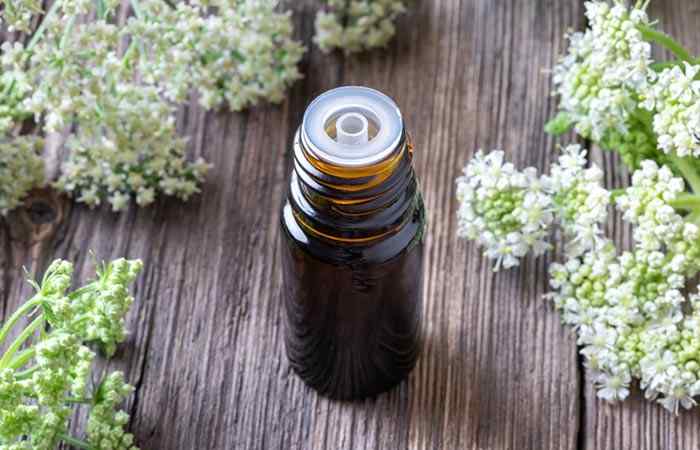
When you need to treat your breath or respiratory problem, you can use Eucalyptus, Monarda, or Elemi oil as an alternative with a similar effect. You can have benefits from the mentioned oil equivalent to Angelica root essential oil.
For Aches and Pains, Juniper and Ginger oil can give you excellent results. These oils are primarily neutral and good pain relief agents.
You may use Yarrow, Geranium, Melissa, or Valerian oil in aroma therapy or to treat your nervous problem. This oil is as effective as angelica root oil in calming your nerve and relieving anxiety.
When you have skin problems but are unwilling to use angelica oil, you may replace it with Cajeput oil. It is as effective as angelica oil in threatening bacterial or fungal cased skin problems.
Health Benefits of Angelica Root Essential Oil
This root essential oil may provide health benefits such as pain relief, stress reduction, and immune system support. Find the best 11 benefits here:
1. Purification of Blood and Body
Angelica oil can purify your blood due to its depurative properties. It can also clear the toxin from your body through urine and sweat. As a result, you can get relief from some ailments related to the accretion of toxins in your body. All of that can boost your immune system and improve your health condition.
2. Promote Good Digestion
You can massage angelica root oil on your lower abdomen for better gut health. It can help to secrete stomach acid and provide you with good digestion. It can also relax the abdomen and intestine muscles, naturally improving motion and releasing toxic gas. Moreover, it can also ease or cure problems like flatulence, dyspepsia, nausea, and acid reflux.
3. Better Bone Health
Angelica oil contains a lot of δ-3-carene (14.2%), which can relieve arthritis-related inflammation. It can also cure some bone issues and improve the overall bone condition. If you have osteoporosis, osteoarthritis, or other bone issues, the regular message of angelica oil can ease your suffering.
4. Anti-fungal use
If you want to protect your skin from fungal infections, you can use this oil. It contains a fair amount of Sabinene (6.1%), which is well known for its anti-fungal functions. You may find some of your skincare product contains this chemical or angelica oil as an ingredient. In contrast, you can use raw oil infused with carrier oil because that may bring you better protection against certain species of fungi.
5. Anti-virus function
Angelica oil can slow down the proliferation or destroy a few species of virtue due to the high level of limonene (16.4%) and α-phellandrene (8.7%). It may not work as a vaccine, but it can help your immune system fight against some viruses that make us sick. This slowing of the virus proliferation can prevent the virus from spreading, including the viruses that generate cancer.
6. Healer of Wounds
The anti-microbial, anti-bacterial, and anti-fungal properties of angelica oil protect your wounded skin from further infection. So you can use it as supplementary to other medicine. It can form granulation tissue by collagen synthesis and regenerate tissue to heal your wound faster. However, it has some side effects that may irritate sensitive skin, so you must consult your health expert before using it on your wound.
7. Cure Anti-anxiety issues
It can cure your anxiety and relieve stress. The presence of Myrcene in angelica oil makes it one of the best oil for aroma therapy, which can reduce anxiety and stress levels. Direct inhalation can give you some immediate benefits as well. However, aromatherapy is the most effective way to reduce anxiety and other stress-related problems.
8. Cough And Respiratory Issues
Angelica oil has expectorant properties due to the presence of α-pinene (29.7%), which can work as a thinner of the mucous and clear the excess phlegm. As a result, inhaling or breathing angelica root oil can ease your cold and catch the related problem. It can also bring comfort to your respiratory problem.
9. Anti-Cancer Properties
Angelica oil is known to have anti-proliferative effects due to its furanocoumarins, which can reduce the expansion or proliferation of cancer cells. The presence of α-phellandrene (8.7%) also makes it one of the most potent essential oils against cancer.
10. An Active nervine
Angelica root oil is a good tonic for nervous problems. A high level of limonene (16.4%) can calm your nerve and save you from harm by sedating your nervous system. It can also be a stimulant when you need to become alert and active.
11. Reduce Fatigue

It can calm and revitalize your body. After consulting an aromatherapist, you can use angelica oil aroma therapy to treat Fatigue and mild insomnia. It has a bit of Myrcene, which can calm your nerve and extenuate the symptoms associated with Fatigue.
How to Use
Angelica is a powerful aromatic oil with numerous potent compounds. You have to learn the method of use before using the oil.
Like all other essential oils, Angelica root is most suitable for tropical uses. Some essentials may be consumable, but you must refrain from consuming angelica oil directly due to its strong and reactive chemical composition.
The best you can do directly is inhale the raw oil or inhale the oil infused in hot water. Do not inhale for too long. A few small sniffs are sufficient for your respiratory problems.
You can use the angelica root oil in aromatherapy and add a few drops to your humidifier. A small number of oil droplets in your living room can help cure your anxiety and depression.
Angelica is an excellent massage oil as well. You can massage raw oil on the body parts having particular problems. You can massage raw oil for more effect or dilute it in a carrier oil and then massage it. For sensitive skin, diluted oil is a safer option.
Precautions and Side Effects
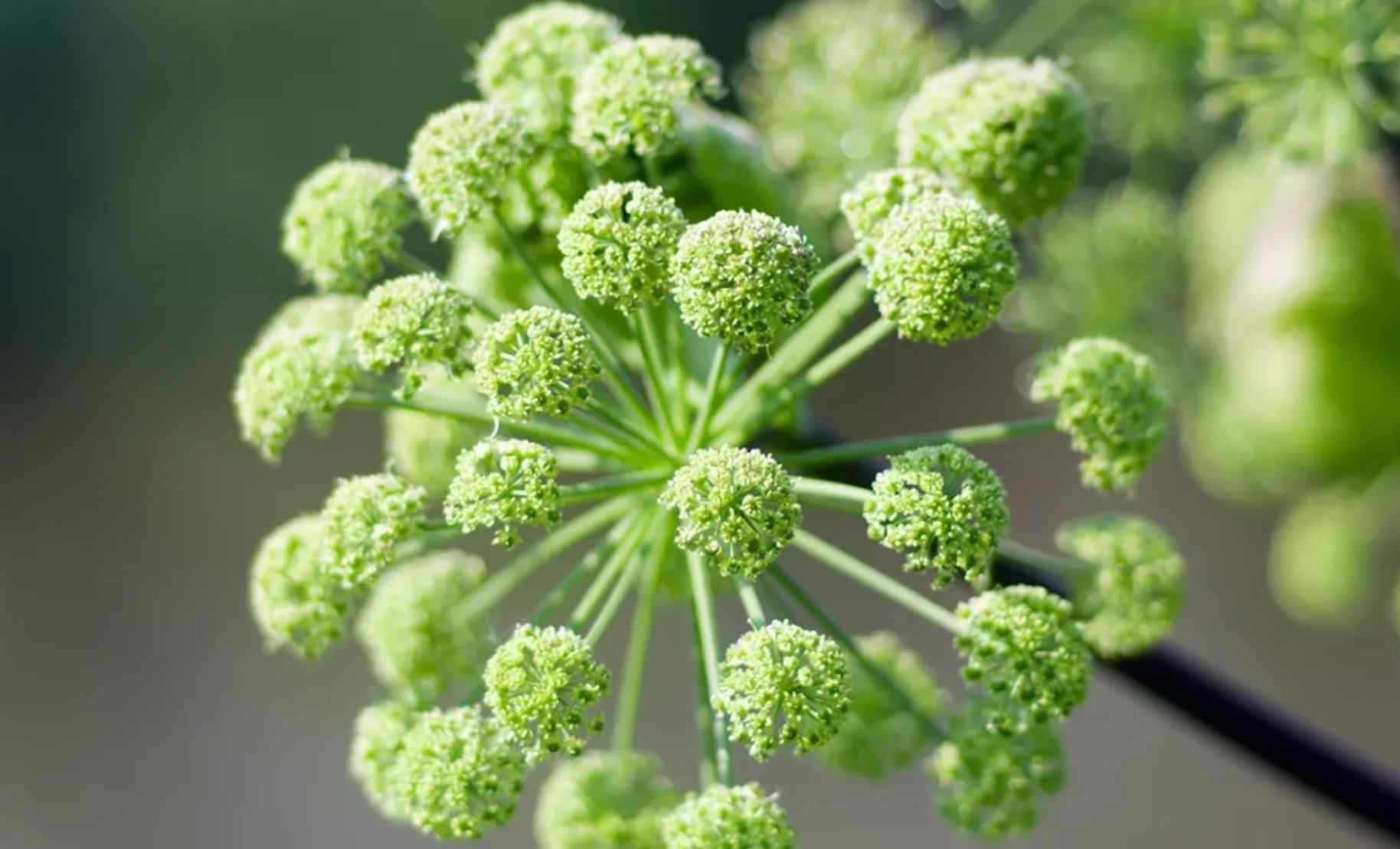
Not all essential oil it reactive to particular physical conditions. However, Angelica root is one of the few very potent and reactive. Especially for diabetes patients and during pregnancy, this oil can be harmful. Besides, it can cause phototoxic effects on sensitive skin. In the following part, we will discuss these three side effects in detail.
Diabetes
Any diabetes patient can use most essential oil safely except Angelica oil. High levels of Ketone in angelica root oil can harm diabetes patients. It can cause severe and erratic side effects. So it would be best to choose other safer options instead of angelica root oil.
During Pregnancy
Angelica root oil is among the few that can harm your baby’s early development. Some chemicals in the oil may disturb your hormonal balance and cause uterine contraction. Consequently, you must avoid essential oil in your early pregnancy without consulting any doctor. With the prescription, you can use a limited amount of safer essential oils in your pregnancy’s second and third trimesters.
Phototoxicity
Phototoxicity happens when you expose your skin to UV rays after applying angelica oil. The effect may vary from person to person, but someone with sensitive skin is more prone to phototoxic effects. If your skin is too sensitive, you must entirely avoid this oil. People with nonsensitive skin also face mild side effects under the summer sun. However, experts recommend exposing your skin to the sun after at least 12 hours of applying this oil.
How to buy Angelica Root Essential Oil
You can buy this oil from your local super shop or online shop. Some pharmaceuticals also sell essential oil like angelica oil. You can find oil from any one of these sources.
Furthermore, you may look for certain reputed brands for pure and reliable products. Eden’s Garden, Revive, Plant Therapy, Aura Cacia, Art Naturals, Rocky Mountain, etc., are some reputed brands that can provide you with the best essential oil.
Along with reliable sources and brands, there are some issues you may keep in mind while buying essential oil. First, you must know the Latin name of the species from which the essential oil has been extracted because most good brands print the exact species’ Latin name on the level.
If the seller provides you with a sample, you must sniff the oil to find the potent, natural, and pleasant smell of angelica root oil. There are different oil grades, like “Therapeutic Grade,” and some are better than others. You must have an explicit knowledge of oil grading to find the appropriate product.
Like all essential oil, it becomes costly when you want quality products. Refrain from falling for the cheap substitute that may be contaminated and can not provide you the benefit you expect and deserve.
Quick Facts
- The name angelica is associated with an angel who describes the benefit of the oil.
- This biennial plant root is hard to extract, making it one of the most expensive essential oil of them all.
- This oil can prevent cancer viruses from proliferating.
- This oil can help you with your arthritis and improve your bone health.
- Patients with diabetes, during pregnancy, and someone with sensitive skin should not use this oil.
Final Thoughts
Angelica plant is a primordial herb with versatile use. You may find the use of the herb in ancient China or medieval Europe. You can now find products from the angelica plant in your closest shop.
In medieval times a total believed the system was related to angelica oil which gave it its great name. Modern science still proves the myriad benefits of this oil. In his article, we have tried to inform you about the fantastic properties of Angelica root essential oil. All the information may help you, and you can benefit from the extraordinary oil.

